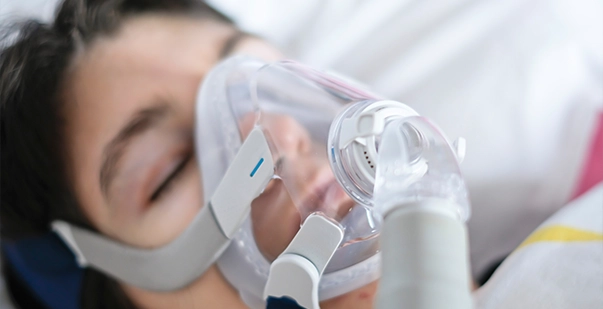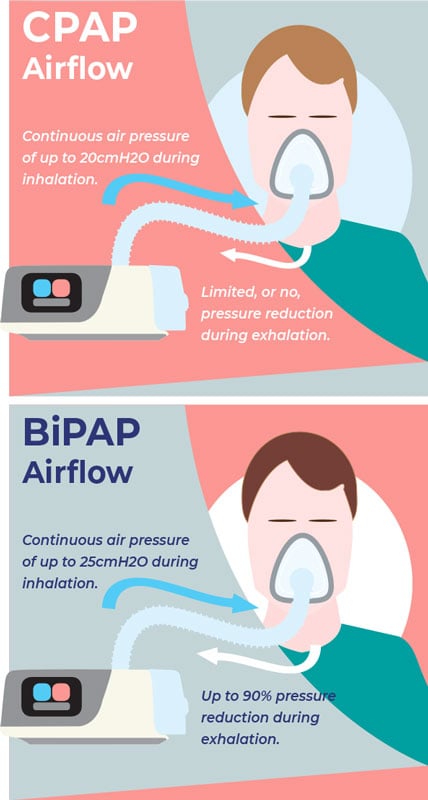Bipap vs. CPAP: Which Is the very best for Your Rest Disorder?
When navigating the complexities of rest disorders, the choice between BiPAP and CPAP treatment is a crucial factor to consider. Each method uses special benefits tailored to particular conditions, yet the choice rests on private person demands and convenience degrees. While CPAP gives a constant air movement suitable for obstructive sleep apnea, BiPAP's dual stress setups may boost convenience for those with even more elaborate respiratory issues. Understanding these differences can substantially affect treatment efficiency, leaving one to consider which alternative truly straightens with their health and wellness requirements and way of life.
Comprehending Sleep Disorders
Rest disorders incorporate a variety of problems that disrupt regular sleep patterns, impacting both the high quality and period of rest. These conditions can manifest in various types, consisting of sleep problems, rest apnea, narcolepsy, troubled leg syndrome, and parasomnias. Each condition offers unique challenges, usually resulting in substantial daytime fatigue, cognitive problems, and emotional disruptions.
Insomnia is defined by problem falling or remaining asleep, while sleep apnea includes duplicated disturbances in breathing throughout sleep, typically bring about fragmented rest. Narcolepsy, on the other hand, is marked by excessive daytime sleepiness and abrupt rest assaults. Restless leg syndrome causes uncomfortable sensations in the legs, motivating an irrepressible desire to relocate them, which can additionally prevent the ability to fall asleep.
The effect of sleep disorders extends beyond private health, affecting overall productivity, connections, and high quality of life. Recognizing the details nature of each disorder is important for efficient diagnosis and treatment. As rest health and wellness comes to be significantly identified as an essential part of total health, addressing these problems is crucial for enhancing both sleep quality and day-to-day functioning.
How CPAP Functions
Continual Favorable Air Passage Pressure (CPAP) therapy is frequently used as a key treatment for obstructive sleep apnea (OSA) The mechanism of CPAP entails using a maker that delivers a stable stream of air through a mask put on throughout sleep. This air flow preserves positive stress in the air passage, stopping the collapse or obstruction of the throat that can happen during rest.
When an individual inhales, the CPAP machine gives a constant flow of air, making certain that the air passage stays open - BiPAP Rental. This not just relieves the signs of OSA, such as snoring and disrupted rest patterns, however also minimizes the associated health risks, consisting of cardio issues and daytime tiredness
The stress settings on a CPAP device can be tailored to meet individual person requirements, frequently established through a rest research study. People usually undertake titration research studies to locate the optimal stress level for their special condition. Normal follow-up and adjustments might be required to guarantee effectiveness and comfort. On the whole, CPAP therapy has been revealed to substantially boost the quality of sleep and total wellness for individuals struggling with obstructive rest apnea.
How BiPAP Functions
BiPAP, or Bilevel Favorable Respiratory Tract Stress, is a customized type of non-invasive ventilation that is specifically useful for people with problems such as complicated sleep apnea or breathing disorders. Unlike CPAP, which supplies a constant stream of air at a solitary stress, BiPAP provides two unique stress settings: a greater inspiratory stress for breathing and view website a reduced expiratory stress for exhalation. This dual-pressure approach enables simpler breathing, decreasing the effort required during exhalation.
The device runs via a mask fitted over the nose or mouth, attached to a maker that produces atmospheric pressure. When the individual breathes in, the device provides the greater stress to help with air flow, making sure that the air passage stays open. Upon exhalation, the machine automatically minimizes the pressure, making it more comfy for the individual to breathe out.

Secret Differences Between BiPAP and CPAP

In contrast, BiPAP (Bilevel Favorable Airway Pressure) supplies 2 various stress continue reading this setups: one for inhalation and a lower one for exhalation. This double pressure system permits more comfy breathing, particularly for clients who battle with exhaling against a continual pressure. BiPAP is usually suggested for individuals with complex sleep apnea, chronic obstructive lung illness (COPD), or those that require extra support throughout rest.
Moreover, the complexity of BiPAP tools usually causes a greater price and calls for a lot more careful titration than CPAP. BiPAP Rental. Comprehending these crucial distinctions can help in identifying which device may be better for details rest disorders, setting the groundwork for informed treatment choices
Selecting the Right Treatment
How can one determine the most ideal treatment for taking care of rest conditions? The decision in between BiPAP and CPAP therapy mainly rests on the specific characteristics of the rest problem, the person's total health and wellness, and their comfort with the tool. CPAP, which delivers a continual stream of air, is generally suggested for obstructive rest apnea (OSA) It maintains an open air passage during rest, successfully protecting against hypopneas and apneas.
On the other hand, BiPAP provides 2 levels of pressure: one for inhalation and a lower one for exhalation. This dual pressure system is advantageous for clients with complex sleep apnea or those that experience trouble exhaling against a continuous stress. In addition, BiPAP is commonly recommended for individuals with respiratory system problems, such as persistent obstructive pulmonary illness (COPD), where differing stress setups can enhance convenience and compliance.
Ultimately, an extensive evaluation by a rest professional, including a sleep study, can assist determine which therapy straightens best with the client's demands. Elements such as convenience, convenience of official statement use, and particular clinical conditions ought to additionally be taken into account to maximize therapy outcomes.
Final Thought
In recap, both BiPAP and CPAP offer distinct purposes in the management of sleep disorders. CPAP is effective for obstructive sleep apnea through constant airflow, while BiPAP provides double stress setups that boost convenience for those with complex sleep apnea or respiratory issues. The option in between these therapies ought to be directed by individual needs and conditions, demanding an extensive examination by a sleep expert to guarantee ideal therapy end results and boosted high quality of sleep.

On the whole, CPAP therapy has been shown to dramatically improve the high quality of rest and overall wellness for individuals experiencing from obstructive sleep apnea.
BiPAP is commonly suggested for patients with complex sleep apnea, chronic obstructive pulmonary illness (COPD), or those that call for extra support during sleep.
CPAP is efficient for obstructive rest apnea through constant air movement, while BiPAP offers dual stress settings that enhance comfort for those with complex sleep apnea or respiratory concerns.